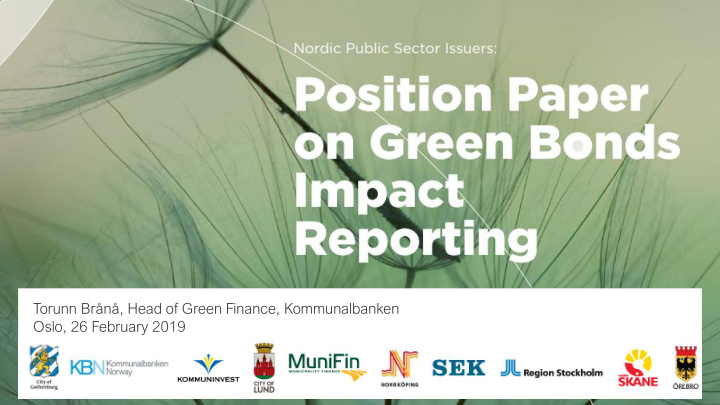



Torunn Brånå, Head of Green Finance, Kommunalbanken Oslo, 26 February 2019
Nordic Position Paper on impact reporting • Based on, and to a large degree aligned, with Harmonized Framework for Impact Reporting and GPB Working Group on Impact Reporting’s sector impact reporting recommendations 1 • Adds more sectors (Green Buildings; Sustainable land use; Adaptation measures) • Designed as a user guide – ”one -stop- shop” – to impact reporting for issuers, while at the same time explaining to investors how signatories do reporting • Suggests baselines and reference scenarios relevant in a Nordic context 1 As of Nov 2018, GBP impact reporting recommendations were available for: Renewable energy and energy efficiency; Water and wastewater management; Waste management and Resource-Efficiency projects; Clean Transportation
Clarifying Nordic positions - Quantify impact based on a) the share financed and b) amounts disbursed and outstanding - Distinguish between reduced and avoided emissions - Quantifying impact for green buildings «OUR» OUTSTANDING SHARE OF THE IMPACT - Same emission factor applied for all electricity projects
Reporting recommendations for Nordic project categories • Renewable energy • Green buildings • Energy efficiency • Clean transportation • Waste management • Water management • Sustainable land use / environmental management • Adaptation measures
Key recommendations FINANCIAL ENVIRONMENTAL PROCEDURAL Report impact solely in relation Commit to report on Scope 1 Annual reporting to the share of the investment Expected impact, with actual and Scope 2 emissions. recommended for dynamic project that issuer has impact as ambition Scope 3 for future portfolios financed Quantitative and qualitative CO2-reduction and impact per National regulations, e.g. Disclose reporting period reporting /CO 2 equivalents + invested USD only if impact is building codes, as baseline and process for project green indicators relevant and quantifiable when relevant inclusion CO 2 -baseline for electricity Report impact based on Annual reporting based on EU 26 + Norway: amounts disbursed and Map project categories to the encouraged also for 380 g CO 2 per kWh outstanding UN SDGs non-dynamic portfolios, but simplified approach may be used Project-by-project or portfolio Summarize impact reporting basis results in an Executive Summary
2019 update – material changes • Quick guide • Indicators for reporting integrated into core Market consultation: document ACTIAM, Affirmative • Bond-by-bond vs. Bond programme reporting AP2, CICERO, KfW, Mirova, NNIP • Recommendations regarding SDGs and Storebrand climate-related physical risk • Clarification on energy savings vs. energy reduced and energy avoided • Executive Summary template
SDGs and climate-related physical risk SUSTAINABLE DEVELOPMENT GOALS • Project categories in PP mapped against relevant SDGs • Encouraging issuers to include SDG information in their impact reporting. Reference to the GBP SDG mapping guidance at icmagroup.org PHYSICAL RISK • Encouraging issuers to be transparent about climate-related physical risk of projects or portfolio, where these are identified. • In such cases, transparency about risk mitigation. • Referencing TCFD recommendations and EBRD report (“Advancing TCFD Guidance on Physical Climate Risks and Opportunities”)
Example from KBN
Executive Summary template Template for one-page Executive Summary has been added: • Breakdown of project portfolio • Overview of quantified impact indicators • Outstanding green bonds • Development in green bond issuance and disbursements • Short descriptions of process for project selection
Electricity baseline: 380 g CO 2 /kWh Mainland Europe including Norway chosen as the relevant baseline since interconnection and export surplus of electricity exist already from the Nordic countries and is planned to increase in the coming years and decades*. Other baselines, e.g. national grid factors, may be used for informational purposes. * Seizing this opportunity depends on: a) build-out of wind capacity and necessary flexibility to handle variability; b) reducing Nordic demand through energy efficiency; and c) setting up the necessary inter-connectors and domestic grid strengthening to enable trade. Source: Nordic Energy Technology Perspectives, 2016 (graph ES.5)
Nordic Position Paper is available for download at: kommunalbanken.no kommuninvest.org munifin.fi
Recommend
More recommend